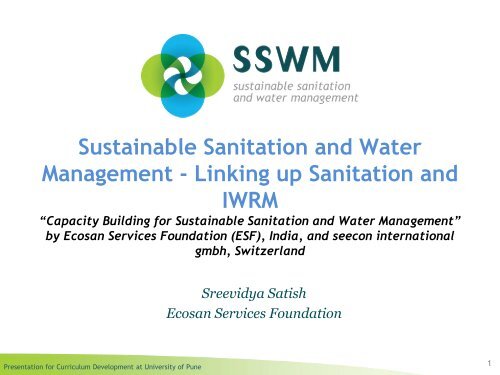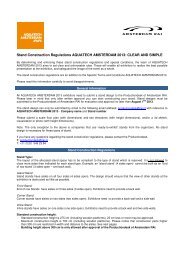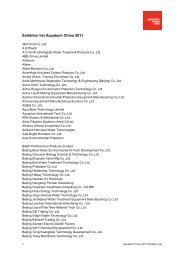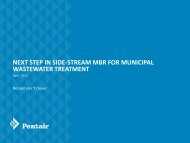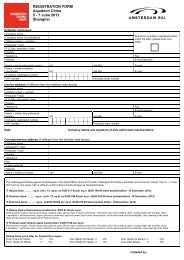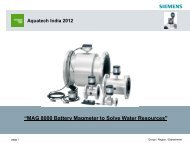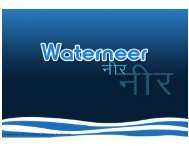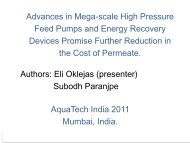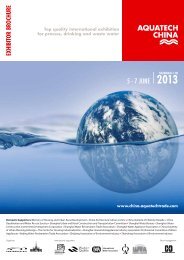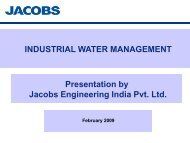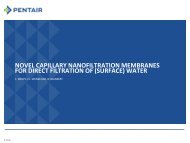Ms. Sreevidya Satish - Aquatechtrade
Ms. Sreevidya Satish - Aquatechtrade
Ms. Sreevidya Satish - Aquatechtrade
Create successful ePaper yourself
Turn your PDF publications into a flip-book with our unique Google optimized e-Paper software.
Sustainable Sanitation and Water<br />
Management - Linking up Sanitation and<br />
IWRM<br />
“Capacity Building for Sustainable Sanitation and Water Management”<br />
by Ecosan Services Foundation (ESF), India, and seecon international<br />
gmbh, Switzerland<br />
<strong>Sreevidya</strong> <strong>Satish</strong><br />
Ecosan Services Foundation<br />
Presentation for Curriculum Development at University of Pune<br />
1
2. 6 billion people<br />
without improved<br />
sanitation.<br />
TODAY.<br />
Source: M. Kropac<br />
Presentation for Curriculum Development at University of Pune<br />
Source: WHO-UNICEF 2010
884 million people<br />
without access to<br />
clean water.<br />
TODAY.<br />
Source: J. Heeb<br />
Presentation for Curriculum Development at University of Pune<br />
Source: WHO-UNICEF 2010
Lack of<br />
water.<br />
TODAY.<br />
Source: REUTERS<br />
http://www.kodak.com/US/images/en/corp/1000words/pennyl/DroughtPaddock.jpg<br />
Presentation for Curriculum Development at University of Pune
Poor<br />
yields.<br />
TODAY.<br />
Source: http://crs-blog.org/wp-content/uploads/2009/02/afg2008018673.jpg<br />
http://www.kodak.com/US/images/en/corp/1000words/pennyl/DroughtPaddock.jpg<br />
Presentation for Curriculum Development at University of Pune
Water<br />
wasted.<br />
TODAY.<br />
Source: http://www.grida.no/publications/rr/sickwater/<br />
Presentation for Curriculum Development at University of Pune
Presentation for Curriculum Development at University of Pune<br />
Situation in South Asia?
Source: WHO-UNICEF 2010<br />
Presentation for Curriculum Development at University of Pune
• Groundwater [Depleted]<br />
• Surface water [Polluted]<br />
• Rainfall [Wasted]<br />
• Population [ ]<br />
• Demand [ ]<br />
• Consumption [ ]<br />
INDIA: SCARCITY of WATER<br />
• Industrial Growth [ ]<br />
• Industrial Growth [ ]<br />
• Economy-Industry [ ]<br />
• Economy-Industry [ ]<br />
• Water Business[ ]<br />
Presentation for Curriculum Development at University of Pune<br />
• Agriculture [affected]<br />
• Health &<br />
Environment [under<br />
pressure]<br />
• Future [ ? ]
Why ?<br />
(Situation Analysis)<br />
Presentation for Curriculum Development at University of Pune
What leads to this situation?<br />
There are four main reasons that lead to today’s situation:<br />
• Sectoral thinking<br />
• Linear approaches to water and nutrient management<br />
• Current conventional approaches in wastewater management<br />
• A lack of sense of ownership and participatory approaches<br />
Presentation for Curriculum Development at University of Pune
What leads to this situation?<br />
(1) Sectoral thinking<br />
Agriculture<br />
Water<br />
Sanitation<br />
Presentation for Curriculum Development at University of Pune
What leads to this situation?<br />
(1) Sectoral thinking<br />
Source: J. Heeb<br />
Source: K. Conradin<br />
Providing Water<br />
But what about the wastewater?<br />
Presentation for Curriculum Development at University of Pune
What leads to this situation?<br />
(2) Linear approach (to water management)<br />
WATER FLOW <br />
WATER<br />
WASTE<br />
WATER<br />
GROUNDWATER<br />
UTILISATION<br />
DISCHARGE INTO<br />
SURFACE WATER<br />
BODIES<br />
Often, in particular in dry areas, non-renewable or ancient groundwater<br />
sources are used as a source of water. However, the groundwater is not<br />
recharged – instead, water is discharged into surface water bodies<br />
(rivers, sea). This leads to groundwater depletion.<br />
Source: Own Graph<br />
Presentation for Curriculum Development at University of Pune
What leads to this situation?<br />
(2) Linear approach (to nutrient flows)<br />
NUTRIENT FLOW <br />
FOOD<br />
WASTE<br />
WATER<br />
NUTRIENT<br />
DEPLETION<br />
NUTRIENT<br />
ACCUMULATION<br />
Today, there is a linear flow of nutrients, from soils (via agricultural<br />
food products) to cities. Nutrients excreted are not recycled, but<br />
essentially end up in aquatic ecosystems.<br />
Source: Own Graph<br />
Presentation for Curriculum Development at University of Pune
What leads to this situation?<br />
What links the these two problems?<br />
N = Nutrients<br />
H 2 0 = Water<br />
NPK<br />
NPK<br />
N<br />
N<br />
N<br />
N +<br />
H 2 0<br />
H 2 0<br />
H 2 0<br />
Water management and wastewater management are considered two<br />
totally different fields. Yet, they are inherently linked.<br />
Presentation for Curriculum Development at University of Pune
Source: WINBLAD and ESREY 2004<br />
What leads to this situation?<br />
(3) Current approaches: Mixing different waste streams<br />
Furthermore, we don’t only mix household wastewater with clean<br />
water.<br />
What happens at the end of the pipe?<br />
Presentation for Curriculum Development at University of Pune
What leads to this situation?<br />
(3) Current approaches: What happens at the end of the pipe?<br />
Worldwide, an estimated<br />
90% of all wastewater does<br />
not receive any treatment<br />
at all.<br />
Two million tons<br />
wastewater discharged<br />
untreated – per day.<br />
Source: http://www.grida.no/publications/rr/sickwater/<br />
Linear approaches<br />
This pollutes a 1000fold<br />
amount of water. Two<br />
billion tons of clean water<br />
polluted per day.<br />
Source: CORCORAN et al. (Eds.) (2010): Sick Water? The central role of wastewater<br />
management in sustainable development. A Rapid Response Assessment. No location: United<br />
Nations Environment Programme, UN-HABITAT, GRID-Arendal.<br />
Presentation for Curriculum Development at University of Pune
What we do to deal with it today?<br />
(3) Current approaches: Mainly technical & expensive approaches<br />
We are currently dealing with these issues with highly technical<br />
approaches:<br />
- State of the art sewage treatment plants – who pays for them?<br />
- Transport of water over large distances.<br />
- Who can afford it?<br />
- And is it sustainable?<br />
Presentation for Curriculum Development at University of Pune
And what about<br />
tomorrow?<br />
Presentation for Curriculum Development at University of Pune
WOULD YOU CALL<br />
IT COMON SENSE?<br />
To mix each day 2 million tons<br />
of highly polluted water with<br />
the 1000-fold amount of clean<br />
water, every day?<br />
Source: http://www.grida.no/publications/rr/sickwater/<br />
Presentation for Curriculum Development at University of Pune
WOULD YOU CALL<br />
IT COMON SENSE?<br />
To spend billions of dollars to<br />
clean this water up again?<br />
Source: www.es-makler.de<br />
Presentation for Curriculum Development at University of Pune
WOULD YOU CALL<br />
IT COMON SENSE?<br />
Source: http://www.grida.no/publications/rr/sickwater/<br />
To discharge this water, when it<br />
would be dearly needed in<br />
agriculture?<br />
Presentation for Curriculum Development at University of Pune
NO, IT IS NOT<br />
COMMON SENSE!<br />
Presentation for Curriculum Development at University of Pune
WHAT WE WOULD NEED…<br />
…IS A<br />
HOLISTIC<br />
APPROACH.<br />
Source: www.sswm.info<br />
Presentation for Curriculum Development at University of Pune
Let’s try to link water, sanitation and agriculture and<br />
look at it as one issue!<br />
Water<br />
Sanitation<br />
Agricultur<br />
e<br />
Presentation for Curriculum Development at University of Pune
Sustainable Sanitation and Water Management (SSWM)…<br />
… is a holistic<br />
approach.<br />
… links sustainable<br />
sanitation with<br />
water<br />
management and<br />
agriculture.<br />
… considers the<br />
water and the<br />
nutrient cycle<br />
together.<br />
Presentation for Curriculum Development at University of Pune
Source: PHADKE 2009<br />
Sustainable Sanitation and Water Management (SSWM)…<br />
… starts simple,<br />
and locally.<br />
… gives equal<br />
importance to<br />
hardware and<br />
software.<br />
… is not a specific<br />
technology, but<br />
about all measures<br />
that aim at making<br />
sanitation and water<br />
management<br />
sustainable.<br />
Presentation for Curriculum Development at University of Pune
Why SSWM Training<br />
courses?<br />
Presentation for Curriculum Development at University of Pune<br />
29
Why Concept should be disseminated?<br />
The lack of trained professionals is particularly problematic, as water<br />
management and sanitation involves multi-disciplinary issues.<br />
to enlighten decision and policy makers, planners, engineers,<br />
instructors, the private sector and users.<br />
Presentation for Curriculum Development at University of Pune<br />
30
Our approach<br />
follows a participatory cross-institutional and interdisciplinary approach<br />
great emphasis is laid on participants’ interaction: besides face-to-face<br />
lectures, group works and case studies, visits to existing projects and roleplays<br />
reveal creativity and make participants think in a holistic way.<br />
In addition to technology, socio-cultural aspects, institutional frameworks,<br />
health & hygiene and the safe application of products derived from<br />
sustainable sanitation facilities are also important parts of the training.<br />
Presentation for Curriculum Development at University of Pune<br />
31
The SSWM Toolbox: Online and Offline<br />
Concept<br />
Guided<br />
Exercise<br />
Process &<br />
Planning<br />
Tools<br />
Implementation<br />
Tools<br />
Background<br />
SSWM<br />
Courses<br />
Open<br />
Source<br />
Library<br />
Glossary<br />
Links to<br />
other<br />
Tools<br />
Training<br />
of<br />
Trainers<br />
32<br />
Presentation for Curriculum Development at University of Pune
Target Groups<br />
Practitioners from the<br />
water, sanitation and<br />
agricultural sector<br />
The “middle level”. Those<br />
who take the lead in projects<br />
on local level<br />
Presentation for Curriculum Development at University of Pune<br />
33
What will course participants gain?<br />
Fully exploit the benefits of the SSWM Toolbox<br />
Develop a thorough theoretical and practical understanding of<br />
Sustainable Sanitation and Water Management<br />
Build a strong and international network of partnering organisations<br />
working in the same field.<br />
Gain the knowledge to meet the challenges of successfully implementing<br />
socially, economically and ecologically viable water management and<br />
sanitation projects.<br />
Presentation for Curriculum Development at University of Pune<br />
34
Participants taking part in course will gain:<br />
Initiating or implementing SSWM projects in their homes,<br />
neighbourhoods or communities, or with their own institution. Advisory<br />
support by seecon international or other course partners can be sought<br />
Joining national or international institutions in need for local SSWM<br />
experts.<br />
Raising awareness with different target groups (from policy makers to<br />
students) on the need for sustainable solutions and the range of<br />
available options.<br />
Depending on the course chosen, organise and/or conduct own trainings<br />
on sustainable sanitation and water management.<br />
Presentation for Curriculum Development at University of Pune<br />
35
Courses overview<br />
Presentation for Curriculum Development at University of Pune<br />
36
Courses done so far<br />
Presentation for Curriculum Development at University of Pune<br />
37
“Linking up Sustainable Sanitation,<br />
Water Management & Agriculture”<br />
SSWM is an initiative<br />
supported by:<br />
Created by:<br />
Presentation for Curriculum Development at University of Pune<br />
38


